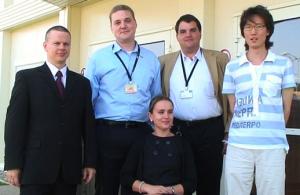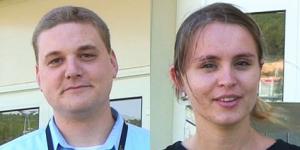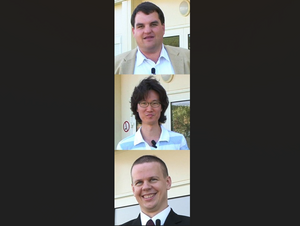Meet the Monaco Fellows
The ITER-Monaco Post-Doctoral Fellows are a group of young and talented scientists selected to pursue research at ITER for two years under the sponsorship of the ITER-Monaco Partnership Arrangement, signed in January 2008. The first five Fellows were chosen from among 28 applicants, and were personally congratulated by HSH Prince Albert II in February of this year at the beginning of their appointments.
At the Post-Doctoral Seminar on 23 July, the Fellows were invited by ITER Director-General Kaname Ikeda, and ITER Principal Deputy Director-General Norbert Holtkamp to present the state of their work. "You have been at ITER since the beginning of the year," said Director-General Ikeda in his opening remarks. "Many of us—at ITER and also on the outside—would like to know how you are enjoying your stay, and how your work is progressing."
American Matthew Jewell focuses his research on the quality analysis and control of niobium-tin (Nb3Sn) superconducting strands. Some 500 tonnes of these strands will be procured for ITER through nine suppliers on three continents. Using a database to keep track of the properties of each unit length of strand—from raw materials right up to the finished product—is an important part of Matt's work at ITER.
He is also working with other researchers to understand more about predicting strand performance. "Historically, it has been difficult to predict conductor performance from individual strand performance," Matt told his colleagues at the Seminar. "By coordinating global research efforts on expected performance under strain with the first test results from qualification samples, we can provide a benchmark for worldwide qualification and production efforts."
Inside the ITER Tokamak, where plasma at millions of degrees Celsius will be only centimetres from material surfaces, some of the tritium fuel will be "captured" by the first wall during operation. Sophie Carpentier, from France, uses physics modelling to provide estimates for this quantity of retained tritium—an important part of meeting nuclear regulations that stipulate the maximum amount of tritium allowable in the vacuum chamber at any one time. Sophie and her colleagues are refining rather crude previous estimates, using and improving upon existing modelling tools. "We aim to develop a picture of the global erosion/redeposition pattern on each blanket shield module within the vacuum vessel in order to provide the best estimates of expected tritium retention before deuterium-tritium operation."
Axel Winter from Germany has joined the team at ITER that is developing the specifications for the ITER plasma control system, or PCS. This complex electronic system will respond to input from 55 diagnostic systems during ITER operation and issue commands within tens of microseconds, thereby closely regulating the performance of the plasma. "We are establishing a framework for the PCS that includes all expected interfaces with operational and diagnostic systems. This work is very important to the success of ITER operation, and must be done before we actually begin to procure hardware and write software code and algorithms," says Axel. "We can only partially base our design on existing tokamak PCSs, as many of the controls necessary for ITER have not yet been implemented on other machines."
Like Sophie, Junghee Kim from Korea is interested in tritium retention, as well as in erosion of divertor surfaces and the creation of "dust" during operation. He is studying the best diagnostic tools for the measurement of these parameters, which will require close monitoring during ITER operation for safety and optimum plasma performance. Measurement requirements have been established for the different systems and candidate diagnostic tools have been identified; Junghee is participating in their evaluation. "By studying competitive techniques, monitoring experimental and theoretical activities and evaluating potential hazards, we are on our way to identifying the most promising diagnostics for ITER to monitor divertor erosion, dust production and tritium retention arising from plasma operation," explains Junghee. "Once chosen, we will integrate the diagnostic system into the design of ITER in the most optimum way."
The physics of energetic plasma ions is the research focus for Evgeny Veshchev from the Russian Federation. It is an important field of study since effective plasma heating and good fast ion confinement are essential for ignition. When fusion-born alpha particles escape from the plasma, they are responsible for energy loss and can also cause first wall damage within tokamaks. Evgeny is working with theoretical predictions as well as simulation results for this phenomenon in order to identify new diagnostic techniques and alternative candidates for lost alpha measurements. "Fusion alpha particles should transfer their energy to the plasma," explains Evgeny, "however some losses are foreseen. Our research work will contribute to the optimization of plasma discharge scenarios and the protection of the machine."




